Syntheses, structures and efficient visible light-driven photocatalytic properties of layered cuprous halides based on two types of building units†
Abstract
Three novel hybrid cuprous halides, [Me3TPT][Cu5I8] (1, Me3TPT = N,N′,N′′-trimethyl-2,4,6-tris(4-pyridyl)-1,3,5-triazine), [Et3TPT][Cu5I8] (2, Et3TPT = N,N′,N′′-triethyl-2,4,6-tris(4-pyridyl)-1,3,5-triazine), and [Me3TPT][Cu5Br8] (3), were solvothermally prepared by using in situ N-alkylated 2,4,6-tri(4-pyridyl)-1,3,5-triazine (TPT) derivatives as structure-directing agents. All the compounds feature layered structures extended by two types of building units, i.e. the chain-like Cu3I6/Cu3Br7 ({Cu3}) cluster and ribbon-like Cu4I10/Cu4Br10 ({Cu4}) cluster. UV-Vis spectra analyses indicate that they are potential semiconductor materials with narrow energy gaps of 1.05, 1.02, and 1.30 eV, respectively. These materials exhibit stable catalytic activity in the sunlight-driven degradation of organic dyes. Theoretical studies revealed that the N-alkylated TPT moieties contributed to the narrow semiconducting behavior, which results in the excellent visible light-driven photocatalytic activity.



 Please wait while we load your content...
Please wait while we load your content...